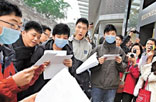Knocking the door open - Nixon's China trip and its legacy
Updated: 2012-02-21 10:21
(Xinhua)
|
|||||||||||
Robert Tansey, who was born in New Jersey in the 1950s, has lived a life that probably would have been much different if Nixon hadn't made his historic visit to China on Feb. 21, 1972.
As a US diplomat for several years and now as Director of External Affairs for the Nature Conservancy's North Asia Region, Tansey has lived in China for about a decade. He recalled the path he and China have taken to arrive at today's close ties.
"As a boy growing up, I loved to look at maps. I knew there was a place called China," Tansey told Xinhua. "I knew China had a lot of people, a long history and a rich culture. I also knew there was a conflict between the United States and China."
Back in the 1950s and '60s, China was commonly known as Red China, or Communist China, among Americans. The breakout of the Cultural Revolution in 1966 only solidified that stereotype.
"Then I knew China was having some cultural revolution - people had Chairman Mao's Little Red Book," Tansey said.
In the meantime, the United States was known to Chinese as Imperialist America through magazines and revolutionary slogans such as "Down with American Imperialism."
However, in the late 1950s and early 1960s, relations between China, the United States and the Soviet Union seesawed.
Ideological divergences between China and the Soviet Union and tensions along the Sino-Russian border, particularly the breakout of the Zhenbao Island border conflict in 1969, led China and the United States to consider the strategic value of resuming ties between their two countries.
Finally, after several rounds of tentative and often indirect contact, the top leadership of China and the United States agreed to start communication.
By 1971, after more than two decades of isolation and hostility across the Pacific Ocean in the wake of the founding of the People's Republic in 1949, the U.S. Table Tennis Team became the first American sports delegation to set foot on Chinese soil since 1949.
Ding Yuanhong, then director of the Chinese Foreign Ministry's U.S. Affairs Department, recalled that at first they didn't want the players to come before Dr. Henry Kissinger's visit. Chairman Mao Zedong agreed.
But according to those close to Chairman Mao, one day, he called in his secretary in the middle of the night and told him to inform the Foreign Ministry to invite the players. Hence, "Ping-Pong diplomacy" was born.
The Ping-Pong event marked a thaw in Sino-U.S. relations that paved the way for President Nixon's visit the following year.
Accompanied by an entourage of officials and journalists, Nixon showed his electorate that he was a bold leader by being the first U.S. president to meet with Chinese top leaders in 22 years.
Indeed, Nixon's China visit, which was shown on TV and featured on the cover of virtually every newspaper and news magazine in the U.S., created a big wave back home.
"It was like this big news. It was kind of like an explosion - who would have expected that?" said Tansey. "For myself, listening to other people and observing other people, we realized something really big had happened."
But, to some, the trip was due to happen. Stephanie Tansey, wife of Robert Tansey and now an educator in dialogue and cross-cultural communication in Beijing, believed the visit was a natural correction of hostile relations.
"I thought that was an excitement because I didn't have any antagonism for Chinese people. And I didn't think about them as enemies," said Stephanie.
During Nixon's visit, the two sides issued the Shanghai Communique, which stated it was in the interest of all nations for the United States and China to work towards the normalization of bilateral relations.
The U.S. and China also agreed that neither they nor any other power should "seek hegemony in the Asia-Pacific region."
The United States also acknowledged the One-China policy and agreed to cut back military installations on Taiwan.
However, after the Nixon Administration, U.S.-China relations wavered until 1979 when the Joint Communique on the Establishment of Diplomatic Relations was issued, formally establishing diplomatic relations between the two countries.




